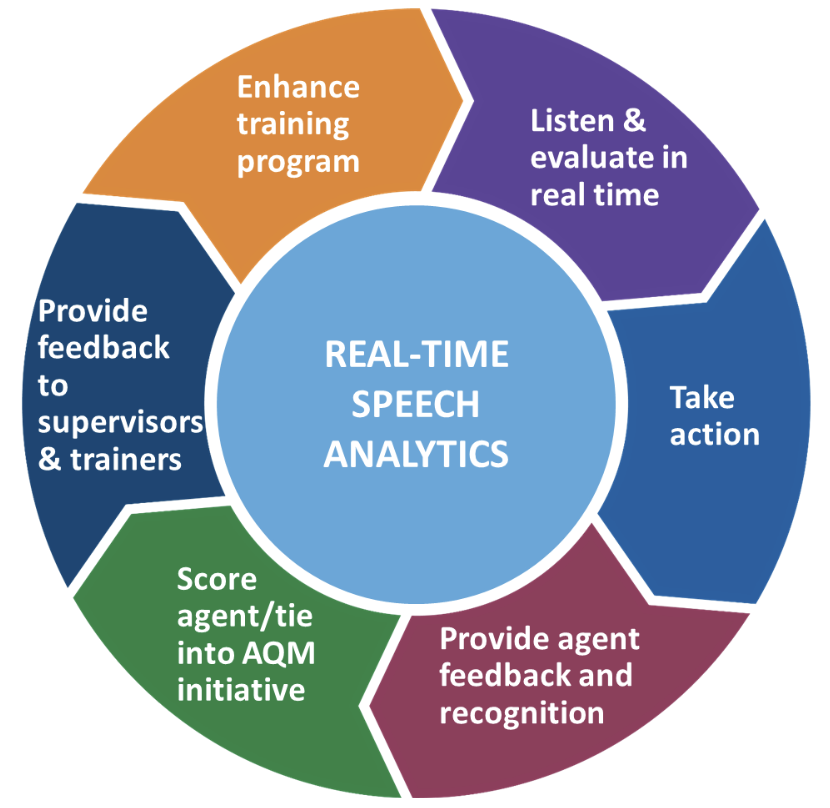Getting Started with Real-Time Speech Analytics
June 2022
By Donna Fluss
Real-time speech analytics is a highly beneficial and practical artificial intelligence (AI)-based application that should be used by contact centers to “listen” to customer conversations and provide guidance to agents as they are helping callers. The objective of real-time speech analytics is to identify and notify agents of customer issues and what to do to fix them, while the caller is on the line. These solutions should also be used to identify and recognize agents for doing an outstanding job.
Applying real-time speech analytics is conceptually simple but practically complex because these are new applications and few companies have their own resources to implement these intelligent solutions. To get started, contact centers should obtain senior leadership support and designate an executive sponsor. Once the sponsor is on board, a project team, including contact center leaders, supervisors, agents, quality management specialists and trainers, should be created to oversee the initiative. Identification of a project manager is imperitive to keep the project moving forward; this should be someone who is not caught up in the day-to-day operation of the contact center. A second essential team member is the real-time operations manager who will be responsible for managing and overseeing the solution on an ongoing basis after it is implemented, including executing the decisions made by the project team.
The project team is responsible for building a business case to justify the investment in a real-time speech analytics application. This is a valuable exercise, as it gives the team an opportunity to identify how the solution will be used and applied in their contact center. Once the investment is approved and the technology selection has been completed, the real-time operations manager, who may be a business analyst or head of contact center operations, for example, should learn how to use the application. This will enable the individual to work with the project team to specify the conditions that trigger the real-time solution to “fire” encouragement, guidance and recommendations to agents. (It is a best practice to identify a backup resource who is also trained.)
At this point, it is time to set up and test the solution. As part of the set-up process, the team needs to select the types of messages, emojis and color-coded alerts (keep in mind that some people are color blind) to send to agents and supervisors, as well as when to send them. (There is a delicate balance between delivering helpful direction and sending too much “stuff.”) In all cases, it’s a good practice to keep the communcations short, concise and clear so that they are beneficial and do not disrupt agents while they are working with customers.
The figure below presents the steps for successfully applying real-time analysis of customer conversations in a contact center. The speech analytics application needs be configured to listen, analyze and send feedback/guidance for calls in real time. For this to occur, the automatic call distributor (ACD) must provide a real-time stream of each call to the application. At this point, the real-time speech analytics application will identify the appropriate actions to take for the benefit of the brand, customer and agent. (This could be for the agent to apologize on behalf of the company, deliver the mini-Miranda, attempt an up-sell, notify a supervisor about a difficult situation, compliment an agent for doing a great job, etc.) Once the appropriate steps or actions are identified, the system provides each agent with the immediate feedback or guidance so that they know the best way to assist each caller.

DMG recommends that contact centers conduct a beta deployment and start by addressing a few real-time scenarios to give agents a couple of weeks to acclimate to the new stream of messages. During this time, the operations manager should work closely with the agents participating in the beta to determine which types of communication and guidance are most effective. After the beta team identifies the best approach for issuing real-time alerts, notifications and recognition, expand the use cases to additional scenarios that will benefit agents and customers. Once this step is completed, it’s time to roll out the solution to the entire staff, which can be done by team, function, site, or any other criteria that allow for a controlled implementation. However, as is always the case with a new application, it is important to train the staff thoroughly before the full roll-out.
One helpful hint. As real-time speech analytics is likely to be new to your contact center, DMG recommends using the vendor’s professional services staff or a third-party consulting firm with proven experience in rolling out the application in your vertical. It’s also a best practice to have these experienced resources train your staff during the system set-up and implementation. This will speed up realization of benefits and payback, even if it increases the cost of the implementation.
Final Thoughts
It’s critical to give agents the right tools to do their job effectively, which is why real-time spech analytics is essential for contact centers. While adoption of real-time speech analytics is in its infancy, these applications have been in the market for close to 10 years. Adoption of these applications is picking up now because they are primarily being delivered from the cloud where they are supported by large processing environments that are necessary for these AI-based applications. DMG recommends that contact centers explore the uses and benefits of these highly powerful and valuable solutions.
